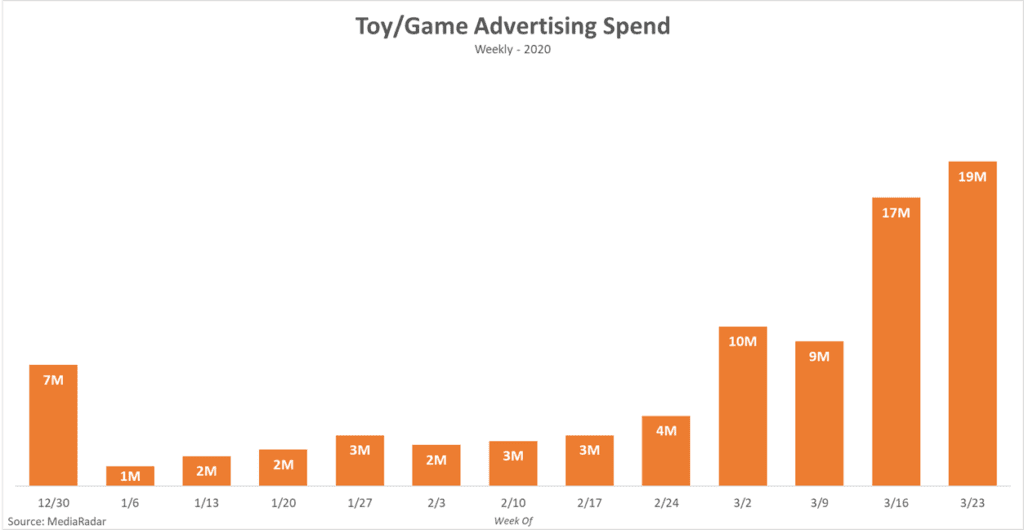The whole family is at home and parents need to work. How are parents getting emails sent with children right next to them?
The answer might be new toys and video games.
Toy sales were not looking good a little over a month ago, when COVID-19 appeared to be a problem primarily based in China. In fact, in late February, Hasbro warned investors of a decrease in revenue due to challenges with overseas factories.
Ironically, Hasbro did not know that the coronavirus crisis would sweep everywhere and shift how families spent the majority of their days. The company’s shares are now up 12% and its current challenge is no longer vacant factories in China, but it’s empty shelves in the States.
The coronavirus pandemic has ushered in a new lifestyle for families. How are toy companies responding with their ads?
We encourage you to subscribe to our blog for the latest data surrounding the advertising industry. We will provide daily updates as COVID-19 continues to make its mark on the US economy.

The spike in toy sells
It’s not just Hasbro. Toy companies across the board are seeing a massive surge in sales.
Research from the NPD Group showed that toy sales were up 26% for the week ending March 21st. Games and puzzles were up 228%, building sets were up 76%, and arts and crafts were up 70%.
Parents need activities for their children to do while they are cooped up at home, especially to prevent too much screen time.
For some families, this may be a time to connect with their kids in a way that harkens back to their childhood. Classic board games like Monopoly, Game of Life and Operation are performing well. But it’s not all about the kids.
“We’re seeing a clear ‘kidult’ and adult trend here,” said Frédérique Tutt, global toy market expert for NPD. “Perhaps some of the buyers are grabbing the opportunity to use their newly found spare time to achieve a long-term dream to build one of these cars in Lego.”
Daniel Radcliffe is a prime example of this. He showed off his 3,200 piece completed Jurassic Park LEGO set on The Late Show with Stephen Colbert.

Most of these sales are being made online through Amazon, Target and Walmart.
It is interesting to note that Amazon has confused toymakers on its policies during this time. Although Amazon said it was not accepting non-essential items into its warehouses, toymakers have received messages directly from Amazon asking for shipments of toys due to high demand.
MediaRadar Data
Do the ad numbers coincide with these new sales? Yes, and by a long shot.
Games and Toys
When looking at a combination of children’s toys and games (i.e. action figures, toy cars, etc.) and adult toys or games (i.e. Board Games, Puzzles, etc.) companies invested $1-4m per week in advertising at the beginning of this year.
In March that number jumped to an average of $13.8m per week.

In March, 89% of the spend from the chart above came from children’s toys and games.
While the large majority of the ads are targeted towards children’s toys and games, not all of the ads are targeted at the kids themselves. 30% of the TV spend in March went to programming not explicitly aimed at children.
The most shocking thing here is that not just one company quickly adjusted. Ad-investment is up across the board.
Here are the Month-over-Month changes in spend between February and March 2020 for different toy companies:
- Mattel is up over 14x
- Hasbro is up over 6x
- Lego is up over 5x
- Playmates Toys is up over 3x
- Spin Master is up over 2x
Ad creatives among toy companies have also changed.
Hasbro launched a new spot highlighting people of all ages enjoying their products indoors. Within the ad, they promote multiple products as part of their new “Bring Home the Fun” initiative, which includes a new website specifically designed to help families during this time.
Video Game Systems
It’s not all about screenless games these days. Video games are benefiting too.
Gaming systems saw a large spike in advertising over recent weeks. The first three weeks of March saw over $14M in ad spend. In comparison, the companies spent just over $10M in Jan-Feb combined.
The key contributor here is Nintendo. The company released a new product (Nintendo Switch Lite) in September 2019 and has been aggressive in its marketing.
Nintendo ran ads most frequently on kids’ entertainment programming. With a price point of $200, it’s a viable option for parents suddenly needing to provide a diversion for their children. However, it appears that the biggest issue for Nintendo is simply keeping it in stock.
Sony’s PlayStation and Microsoft’s XBOX are keeping their marketing minimal. Playstation is spending less than $100k a week, while Xbox is spending between $200-300k a week. For these companies, the timing is poor. They both have new consoles coming out in the coming fall, but their current product offering is stale.
As coronavirus continues to weave itself into our economy, some industries are set up to win more than others. While the gravity of COVID-19 is not lost on us, it does cheer us up a bit to imagine families coming together over board games and adults completing their childhood LEGO dreams.
For more updates like this, stay tuned. Subscribe to our blog for more updates on coronavirus and its mark on the economy.



